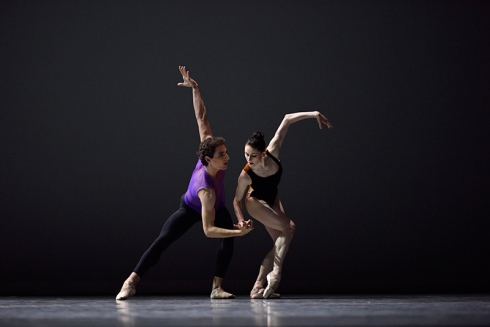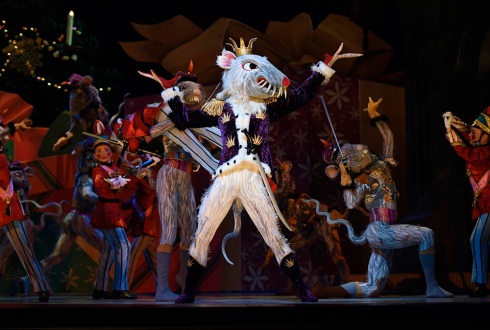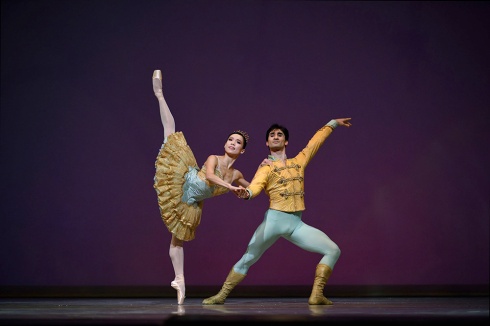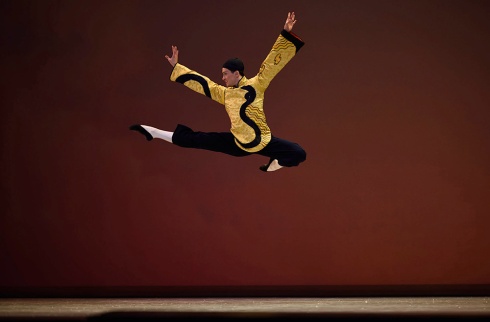The June 28 IBC Gala definitely had its moments of excitement, gratification, surprises plus lapses in taste and, to use old—fashioned terms, breeding and courtesy. These rips in the social fabric largely lay in Caucasian behavior, not amongst the visitors. And, my dear, the wearing apparel! You’d think me a character in the back row of the Confederate ball when Scarlett O’Hara Hampton danced with Rhett Butler for one hundred dollars in gold!
The dancers participating in the Gala started with Peter LeBreton Merz’ heroic effort to accommodate sixty two dancers on the Thalia Mara stage, dancing to Wolfgang Amadeuz Mozart’s overture to Cosi fan Tutte under the title Fete de Ballet. Merz accomplished this by waves of arriving and departing lines, traveling circular jetes for the men, then having to partner young girls, spreading the task in one or two brief ensembles. The sound of toe shoe boxes were prominent, making me realize that the Thalia Mara administrators may have a problem in their marley floor. There is a spot down stage right where “here’s a river and here’s a lake and here’s where you make a big mistake,” the fate of several contestants during the three rounds.
The Junior Best Couple, Yasmin Lomondo and Gustavo Carvalho of Brazil, both of whom garnered Bronze medals for Junior Women and Junior Men, performed the Grand pas de deux from The Nutcracker. Notable in their interpretation is the courtesy and rapport between them. Lomondo looked at Carvalho at each appropriate moment, seeming to draw radiance from each exchanged glance, enough to make one believe totally in romance.
Paulina Guraieb Abella of Mexico, who shared the Women’s Junior Bronze, followed with a variation from Paquita,made memorable by Park Sae-Eun of Korea in 2006 requiring stroking of the arms, pirouettes ending in exact fifth positions and brief bourrees and a sudden finish. Large-boned, Abella, though not yet a dancer of nuance, dances with strong, clear and confident movement.
Mackenzie Richter, U.S.A., Junior Women’s Silver, brought Trey McIntyre’s Excerpt from Bad Winter to Chaplinesque life, her arm gestures deftly punctuating the plaintiff sounds of Arthur Tracy singing “Pennies from Heaven.”
Eum Jinsol [Korean style of family name first] sliced through the air in Solor’s variation from La Bayadere where sissonnes commence the variation followed swooping side movements, circling the stage with low flying jetes, ending in the spin of pirouettes. Eum’s elevation and swiftness is admirable, although any motivation of this variation by anyone I’ve seen dance it is a mystery. Solor is in a dream, probably induced by opium; my guess is he’s floating in his ghostly reunion with Nikiya. I suspect this early manifestation of Marius Petipa’s skill with women in ensemble never was all that strong on motivation, even though this was precisely the historical period of The Great Game between Britain and Russia for influence in Afghanistan and the Hindu Kush. Such connections are likely to elude junior contestants.
The Junior Women’s Gold, Gisela Bethea, unfortunately was not allowed to dance the Grand Pas from the Sleeping Beauty, but instead repeated Matthew Neenan’s Excerpt from “The Last Glass” with her partner Michal Slawomir Wozniak, and, clearly, made it memorable as a beguiling young woman a flutter with reciprocated love.
The Junior Men’s Gold, He Taiye [again the Asian style of address] from the People’s Republic of China, wearing impeccable white with gold accents on the tunic started the variation of The Nutcracker Grand Pas de deux. On the small and slender side, He was infinitely correct and precise, ending in a flourish, a near waist-high a la seconde.
Since the Senior Golds medalists are permitted two appearances, their selections are divided between classical and contemporary, evidence of the worthiness of their selection. For Shiori Kase of Japan, it was Trey McIntyre’s Excerpt from “Robust American Love,” danced to the Tiger Mountain Peasant Song for which she wore a diaphanous black redingote over a white unitard. To an unforgiving series of steps, Kase brought a Madame Butterfly sensibility without sacrificing strength or correctness, her koto-string like plaintive interpretation an acute touch for the demonic verbal ending.
The Senior Male Gold was awarded to Hansol Jeong of Korea and his classical selection was Basilio’s variation from the Don Quixote wedding pas de deux . Resplendent in black with elaborate gold accents on the shoulders and sleeves, Hansol danced crisply, with a serious expression. After a spectacular series of pirouettes, the audience roared its excitement and Hansol permitted himself a smile of satisfaction, almost as if he had completed a set of bold black strokes of calligraphy. The smile, curving devilishly at the ends, made me wonder what his interpretation would be like in the full-length Don Quixote. Short or long, the audience roared approval.
Tamako Miyazaki and her partner Ariel Breitman completed the first half of the program with the Esmeralda Pas de Deux, enabling her to demonstrate her prolonged talent for balancing, supported by Breitman whose own flourish and presentation made Miyazaki look just that much better.
Le Corsaire got its opportunity with the best Senior Couple, Ha Ji-Seok and one of the senior female bronze winners Jung Ga-yeon. Slender and classical, their rendition sizzled with intensity.
Senior Men’s Bronze Ivan Duarte danced his contemporary solo Field Boy to the Theodorakis’ music starting slowly, deliberately like most Greek male dancing, increasing to the frenetic in the portrait of a Charlie Brown type of guy.
Senior men’s silver winner Yun Byul danced the Acteon variation from Esmeralda’s Diana and Acteon Pas de deux, another Korean whose pleasure and intensity compensated for his tall, slender build.
Displaying Rendez-vous, Nicolas Blanc’s prize for choreography, were Senior Bronze medalist Aaron Smyth and Cara Marie Gary.
Shiori Kase, Senior Women’s Gold danced Medora’s variation from Le Corsaire, again in her elegant blue tutu with the same warm correctness that marked every step she displayed during the competition.
It was left to Hansol Jeong to dance one of the Trey McIntyre solos for the seniors, the excerpt from (serious) which he did with the off-handed, distinct flair that had marked all of his dancing.
Completing the program Was senior women’s Silver Irina Sapozhikova with Joseph Phillips dancing the Don Quixote pas de deux with their seeming relaxed presentation, he with special emphasis in his tours and she waving her fan aloft during her very correct fouettes executed to the four corners of the stage, sometimes single, sometimes double. The couple gave the evening a just finale.
Following the second intermission the awards were distributed, following a tribute to Executive Director Sue Lobrano who leaves her position in September with plans for a December wedding. It brought forth IBC’s Haley Fisackerly to present her with an IBC citation. When the Gold Medals were awarded, the respective national anthems were played, the Gold, Silver and Bronze recipients arrayed in Olympic fashion on a pedastal.
Shall I gossip on or stick to the subject on stage? Let’s go with the gossip, displaying the dubious side of my character. To start, I know styles change and individual tastes vary. But I wonder whether women, budding, in full flower, or slightly wilted regard themselves as part of a visual landscape that includes other humans with eyes for line, proportion as well as curves. My mother, when she permitted herself to be snotty would comment, “She has her youth to recommend her,” when observing a young woman with too tight a dress to move easily or shoes breaking a natural walk. When the awards for scholarships were announced and teen-agers walked across the stage to accept a certificate for study which just might lead towards a coveted tutu, classical or romantic, what were they thinking? Wedge-shaped shoes making a noise, shoes hinderiing their walk, and skirts? At least two looked like fugitives from the swimming pool. It occurred to me fashion magazines and store mannikins specialize in poses and postures which have nothing to do with motion. And these young things are engaged in an endeavor celebrating beautiful,sustained movement! It very much looks like clothing notes may need to be included for those enrolling in IBC USA’s International School in 2018.
I would like to believe that talent and taste are bosom buddies. There might even be a seminar for students on make up off, as well as on stage, and a specialist analyzing facial contours, and how to minimize less than perfect proportions off stage as well as on. Certainly the days have passed, so well recorded in Alexandra Danilova’s memoir, Choura, when dancers on tour or in an engagement in a city were expected to wear hats, silk stockings in addition to current style. The idea was to convey glamour and a certain mystique. Styles have changed, but expectations do linger.
That said, it was gratifying to register the Asians never lacked for manners; a bow to the teachers and the jurors and then to the audience, the Koreans notable with politeness mingled with pleasure at their success.
It took Claudia Shaw some time to close up her taping equipment, so by the time we mounted the steps at the Mississippi Museum of Art for Entergy’s Grand Prix Ball, we could hear it loud and clear in the Garden the Museum has built on what was once a parking lot between their building and their former location. Entergy clearly is new to post Gala IBC entertainment; the food had virtually disappeared for anyone fifteen minutes past the portal opening.
Our compensation came the following day when the medalists came to claim their DVD’s, a clump of handsome young Korean medalists. Tamako Miyasaki with Shiori Kase autographed a DVD, a gift to 2010 International Dance School teacher Arleen Sugano and her mother Kimiko Sugano, who had served as an interpreter in 1990.
Tags: AAron Smyth, Alexandra Danilova, Ariel Breitman, Arleen Sugano, Arthur Tracy, Byul Yun, Cara Marie Gary, Claudia Shaw, Eum Jinsol, Ga-yeon Jung, Gisele Bethea, Gustavo Carvalho, Haley Fisackerly, Hansol Jeong, He Taiye, Irina Sapozhnikova, Ivan Duarte, Ji Seok Ha, Joseph Phillips, Kimiko Sugano, Mackenzie Richter, Marius Petipa, Matthew Neenan, Michal Slawomir Wozniak, Mississippi Museum of Art, Nicolas Blanc, Paulina Guraieb Abella, Peter LeBreton Merz, Sae Eun Park, Shiori Kase, Sue Lobrano, Tamako Miyazaki, Trey McIntyre, Wolfgang Amadeuz Mozart, Yasmin Lomondo




